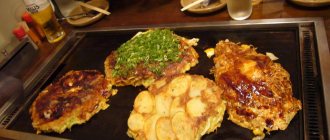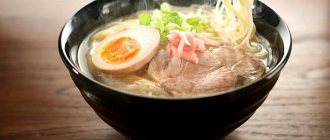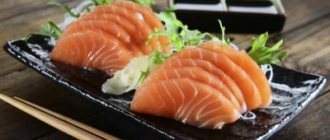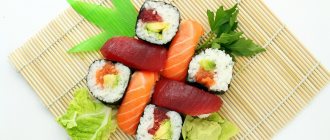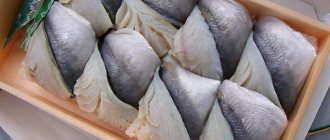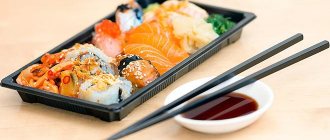Let's talk about sushi: myths, art, creativity November 13, 2014, 00:00 | Galina Zamyslova
6 chosen
Traditional Japanese food has literally taken over the whole world. Having tried this original dish for the first time, few people remain indifferent. Appetizing in appearance, with a delicate taste and some special appeal, these small works of culinary art have become something special, and not just food. Sushi is a reason to meet with friends, sushi is a festive seasoning for any pleasant thing in life, sushi is a cure for a bad mood. But what do we know about sushi?
Sushi is a traditional Japanese dish, invented many centuries ago and passed down from generation to generation. You can call it a calling card of the country and a taste association with Japanese culture. It’s difficult to understand the varieties and varieties at first glance, and when ordering, we simply point our finger at the image and say: “This is for us!” Let's try to understand a little about the types of sushi and the prevailing ideas about them.
What kind of sushi is this?
The rolls we love (maki, makizushi, sushi wrapped in a sheet of nori) are nothing more than a type of sushi, which in turn is divided into:
- Hosomaki are thin, simple rolls made with only one filling and wrapped in half a sheet of nori.
- futomaki - thick (branded) rolls, with different combinations of several types of filling, wrapped in a large sheet of noria.
- Uramaki are inside-out rolls wrapped in such a way that the filling is inside the nori sheet and the rice is on the outside.
- temaki - cones or bags made of noria sheets filled with filling and rice.
Nigiri sushi (nigirizushi) is a lump of rice with a piece of fish on top, sometimes wrapped in a thin strip of nori.
Gunkan-maki (gunkanmaki, gunkan) - oval-shaped sushi, wrapped in a strip of noria with filling laid on top.
Oshizushi is pressed sushi in the form of blocks, prepared using an osabiko, a special wooden device.
Inarizushi (inari) are bags of deep-fried tofu, scrambled eggs or dried pumpkin filled with rice.
Chirashizushi - loose sushi. Rice is simply laid out on a plate, and various seafood are beautifully laid out on top of it (edomae chirashizushi), or everything is simply mixed together (gomokuzushi).
Narezushi is the oldest type of sushi, prepared from specially salted fish, layered with rice.
| How to figure out the fillings? The name of the filling is present in the name of the sushi. For example: unagi - with eel, and ebi - with shrimp. |
Myths about sushi
The sushi we love has been talked about, talked about and will continue to be talked about. Some consider them the healthiest food, others consider them harmful and even dangerous. There are also debates about the correct way to eat sushi and what to eat it with and what to wash it down with. What myths surround this food, tempting in all respects?
- Sushi is dangerous because it contains raw fish! In fact, only sashimi is prepared with raw fish. Fish is just one type of filling in sushi. They prepare sushi with boiled shrimp, marinated and smoked fish, vegetable (vegetarian) - for every taste!
- Sushi must be eaten with soy sauce. In fact, soy sauce can ruin the taste of some types of sushi. Nikiri sauce, served with sashimi in restaurants, combines broth, soy sauce, sake and spices. There are as many recipes for nikiri as there are chefs who prepare it, each adding something of their own.
- Be sure to add wasabi. Some people mix wasabi with soy sauce, others just put a drop directly on the sushi. In fact, wasabi can overwhelm the taste of a dish, and sometimes it is already included in its composition.
- Ginger is a garnish! If you just love pickled ginger, eat it to your heart's content, but it's really meant to transition from one type of sushi to another, cutting through the aftertaste.
Creative approach
A good cook is always an artist! This can also be said about “sushi master” - this is the name of the profession of a person who devotes himself to preparing this dish. Even the most ordinary set of rolls looks very tempting and appetizing, but there are Masters of the highest category who turn every dish they prepare into a work of art. Sushi pictures, sushi sculptures and sushi, highly valued not only for their beauty.
| Sculptures from the Tomica series, price $270 per figurine |
Created by the creative duo Paramodel, the miniature sculptures are actually inedible. These are miniature Tomica trucks loaded with tasty-looking but plastic sushi. Paramodel's sculptures inspired sushi restaurant owners, and customers began to be served sushi in exactly this form - on toy platforms.
| The most expensive sushi in the world |
The most expensive rolls in the world were created by Manila chef Angelito Araneta. They contain 20-karat African diamonds and 24-karat gold leaf, which is why they cost about $3,000 for a serving of 4 rolls. The cook does not hide the rest of the more edible ingredients of the dish: 12 year old Italian balsamic vinegar, Japanese rice, virgin water, Muscovado sugar, Norwegian pink salmon and its caviar, cucumber, mango, foie gras, sea cucumber, wild saffron, mayonnaise and pearls. By the way, eating diamonds and pearls is not necessary.
| Sushi gallery |
Tokyo artist Takayo Kyota creates sushi paintings. The wrapped roll does not look very presentable, but once you cut it into portions, inside there is a recognizable picture, cartoon characters, etc. Each grain of rice has its own place, and sometimes the picture is not always successful the first time, because if you squeeze the roll a little harder, the layers of rice shift, destroying the intended image.
Sometimes you just want to go with your best friends and just eat rolls, affectionately calling them in your own way “sushki”, and the sushi cafe “dryer”. After all, this dish has already settled on the list of our culinary preferences, isn’t it?
Galina Zamyslova , iledebeaute.ru
Photo: hanayuubou.com, tieba.baidu.com, shutupcrystal.blogspot. com, theendearingdesigner.com, designyoutrust.com, lifeglobe.net, supergreenlandmarket.com
Myth No. 1. Rolls - a traditional Japanese dish
This myth is the most common misconception.
The association “rolls are a traditional Japanese food” is firmly entrenched in the minds of Russian people. In fact, rolls were invented relatively recently - in the 1970s, and the birthplace of the recipe is considered to be... the USA. Ichira Mashita, a Japanese chef working in Los Angeles, tried to invent a new interpretation of traditional dishes and... came up with the California roll. The Americans liked this dish and became very, very popular. Soon other chefs followed the trend, coming up with their own versions of the rolls. Today rolls are served in many Japanese restaurants, but it is still wrong to classify this dish as traditional Japanese cuisine.
Ordering rolls in Tokyo is the fashion of today
Myth No. 2. Fish is the main ingredient in sushi and rolls
Of course, fish is an important element of sushi and rolls, but the main star is the rice. Japanese cuisine is filled with philosophy, and the ability to pay attention to the subtlest shades of taste is the key idea of the Japanese meal. Cooking rice correctly is a real art. For the chef, it is important to choose the right rice , maintain the perfect balance between salt, sugar, red or white vinegar, and sometimes sake.
Sushi chefs have the opinion that anyone can buy good fish, but only a true master can prepare the right rice, highlighting its delicate taste and achieving the desired grain texture.
In Japan, raw rice is called o-kome, and cooked rice is called go-han. It is worth noting that the Japanese add the politeness prefixes “o-” and “go-” only before the words that are most important to them. It is no coincidence that in top-class restaurants rice is served only at the end of lunch.
Cooking rice for sushi and rolls is the main skill of a sushi chef
Main types of sushi
- nigirizushi (made by hand). This is the most ancient way of preparing sushi. It was he who was invented by Master Yohei. Only these days, an elongated lump of rice is additionally wrapped in a thin strip of seaweed (nori)
- Gunkan-maki . Using your hands, the rice is shaped into an oval shape, which is wrapped around the edge with a strip of nori to give it a “ship” look. Caviar, beans and sometimes salad are used as filling
- Makizushi (twisted rolls). Rice is formed into a roll, most often wrapped in a sheet of nori or a thin omelette. There are several varieties: futomaki, hosomaki, temakizushi, uramaki. Depending on the type, vegetables, fish, caviar, sesame seeds are added inside and the rolls are given different shapes and sizes.
- oshizushi (cooked under pressure). The filling is placed by the master on the bottom of a special device, covered with rice on top, and then pressed. Served in small slices
- inarizushi (with filling). A little rice is poured into a bag made from fried tofu, scrambled eggs or dried pumpkin.
- chirashizushi (scattered). A small amount of boiled rice is poured onto the dish, which is covered with filling on top
- narezushi. This is the most ancient type of sushi, when fish and rice are marinated in a special way for six months. After which it is considered fit for food.
Myth No. 3. Raw, freshly caught fish is always used for sushi and rolls.
Many sushi, rolls and sashimi are indeed prepared from freshly caught raw fish, but there are exceptions.
Traditional Japanese recipes contain certain types of fish that acquire a special taste after aging or a special marinating process. These are hirame fish , bluefin tuna, Japanese Madai grouper and fugu fish . Each fish has its own aging time and a way to reveal its unique taste.
In Japan, a whole system of purchasing and delivering freshly caught fish to restaurants operates smoothly, where special fish markets (markets) are an indispensable participant. Fresh fish is served to guests on the day of catch, and abroad (including in Russia) they often (very often!) use chilled and even defrosted fish.
To eat sushi and rolls with fresh fish, you need to live by the sea, for example, in Okayama, Japan
The entire meal should take ten to fifteen minutes.
In Japan they don’t eat a lot at all; usually the serving size is equal to the volume that fits in folded palms. And you can easily eat 5-6 rolls in 10 minutes. But the reason why such a rule appeared is, after all, not the Japanese habit of eating little.
When eateries began to appear on the streets en masse, whose cooks rolled rice rolls and put fresh fish on top of them, the number of food poisonings began to increase: the fish quickly spoiled. Therefore, the scheme had to be slightly revised. Japanese masters began to cut off a piece of chilled fish and place it on rice only at the time of ordering. Visitors had to eat their rolls in no more than 15 minutes, otherwise in case of poisoning they only had themselves to blame.
Myth No. 4. The green, burning mass served in a restaurant with sushi or rolls is always wasabi
The history of wasabi as “Japanese horseradish” began in 1396 and continues to this day. The plant is a perennial herb, from the root of which the seasoning is prepared. Recent scientific research has proven that real Japanese wasabi can destroy most known bacteria in raw fish. Historically, wasabi was served with sushi for this very purpose before the advent of modern methods of food preservation and disinfection.
Real Japanese wasabi is quite expensive to bring to Russia, so the vast majority of restaurants use imitation in the form of a dry mixture of European daikon or “wasabi powder” of dried horseradish with mustard, to which starch and dyes are added. By the way, the taste of real wasabi is not so spicy!
In Japan, wasabi is added to sushi by the chef himself. Dip the sushi in soy sauce for a second or dip a ginger leaf in the sauce and brush the sushi with it. By the way, eating sushi with your hands is quite acceptable.
This is what real Japanese wasabi looks like
Problematic attitude towards Japanese sushi in Russia
Sushi appeared here relatively recently. Yes exactly. Of course, not everyone was mentally prepared to eat raw fish in various variations. This is expected and quite logical.
Those times are gone, but unfortunately, even today not everyone is able to distinguish real sushi from a cheap fake. Sometimes it becomes offensive when you hear a remark like:
… “I finally decided to try sushi and discovered that it was a rare disgusting thing. It’s good that at least I haven’t been poisoned yet”...
Therefore, I would like to make my contribution, albeit a small one, in establishing the correct image of this product and methods of presenting it.
Similar articles
14 differences between Japanese women and Chinese women. The big difference is in a non-serious context.
18/10/2020
Is it true that the Japanese don't like handshakes?
28/10/2020
Actually, there are several types of serving and variations of ingredients in sushi. It may seem strange, but nowhere except Japan itself would I risk eating sushi using raw sea fish or Ebi shrimp .
At the same time, I understand that some types of sushi without this very fish can be successfully prepared here. But now I won’t dwell on recipes, but will share a little impressions of a sushi bar in the Japanese town of Toyokawa.
Myth No. 5. According to tradition, sushi should be washed down with sake.
This misconception that Japanese people drink sake with sushi may have been shaped by movies and a lack of knowledge about other Japanese drinks.
The traditional drink for sushi in Japan is green tea. It helps cleanse your taste buds and enjoy the pure taste of every bite of sushi. In restaurants, rice balls are washed down with traditional genmai-cha - green tea with fried rice.
Sushi and rolls are traditionally served with green tea in Japan.
Sushi is eaten for lunch, not dinner.
There are several reasons for this, one of them is that the Japanese prefer to eat heavy food during the day (yes, they consider rolls to be heavy food). For dinner - mostly light soups or salads. The second is that previously all the fish were brought to the market exclusively early in the morning. It could go bad in a day, as evidenced mainly by those who ate rolls in the evening.
After local residents realized the danger, they stopped taking risks and eating sushi in the evenings.
Myth No. 6. You can make sushi at home yourself
Sushi is a dish that reflects the aesthetics of Japanese cuisine. It is laconic and seemingly uncomplicated, but external simplicity is deceptive.
It is impossible to make traditional Japanese sushi at home on your own; it is no coincidence that the profession of a sushi chef takes decades to train. During this time, the chefs learn the basics of culinary art and the subtleties of preparing dishes. Of course, it is possible to recreate such recipes without proper experience, but the result will be extremely far from the original.
The Japanese themselves do not prepare sushi at home; they trust it to professionals. For the Japanese, sushi is not an everyday food at all, but a dish that is eaten in special establishments. In Russia, sushi and rolls have become a popular snack. These dishes are prepared at home by yourself, and more often they order delivery of “Japanese food” from a nearby restaurant or cafe.
Today, sushi and rolls can be bought on every corner, and they are prepared by amateur chefs. Of course, this helps to popularize Japanese cuisine, but on the other hand, the philosophy and understanding of the value of authentic dishes has been lost. Therefore, to eat real Japanese sushi and rolls, be sure to go to a good Japanese restaurant. Good sushi is expensive and a table at the iconic sushi must be booked in advance.
The most famous place in Japan is a 10-seat restaurant in a subway passage, where 90-year-old Jiro Ono . The restaurant received 3 stars from the Michelin guide, the film “Jiro Dreams of Sushi” was made about it, and the recording was a month in advance. For $320, Jiro creates 21 pieces of sushi right in front of you. They need to be eaten immediately, while they remember the warmth of the master’s hands. Jiro is one of those Japanese who believe that perfection can be achieved only by doing one thing for many years. Talent is important, but honing your craft is the most important thing. It is no coincidence that Jiro-san buys the ingredients for his sushi from sellers who sell only one type of product, but an excellent one!
Real Japanese sushi and rolls can only be made by a professional
Pour out the Coca-Cola! Drink tea or sake.
Real sake has a strength of only 20 degrees. It is served in a special clay vessel - a jug - and with small glasses. In Russia, this drink is usually simply poured into glasses and offered to guests. But in Japan, the guest is asked what kind of serving he would like.
Sake can be served either chilled to 4-5 degrees or heated to 60 degrees. The last option is for those who want to get drunk quickly, and the cold one is for those who like light drinks.
But there is also a rule among the locals: “Good sake is drunk cold, bad sake is drunk warm.” It is believed that a drink of poor quality is heated so that all the unpleasant odors evaporate from it.
Many people complain that sake doesn't make them drunk. The fact is that you need to drink it not like vodka - in one gulp - but in small sips. In Japan, there is even an old student recipe: pour a glass of beer into a plate and drink it with a spoon, as if you were eating soup. You'll be drunk in half an hour.
Myth No. 7. Cheap soy sauce served with sushi
Due to the fact that soy sauce is always served with sushi, many people think that this product is cheap and has no gastronomic value. But in fact, this sauce deserves our respect, because it is more than three thousand years old, and during this time the technology of its production has remained virtually unchanged. Modern soy sauce is a fermentation product that is produced using traditional technologies from soybeans, wheat, a special fungal culture, water and salt. During the process of natural fermentation, yeast and other microorganisms change the color of the soybean to a darker one, and the taste to a brighter one: the sauce acquires that “fifth” taste - umami and a pleasant spicy aroma. Real soy sauce takes a long time to prepare—from four months or even longer.
Each bottle of natural soy sauce contains the experience of generations, the careful work of many people and natural strength. Therefore, such a product cannot be cheap.
Sushi is always served with soy sauce.
